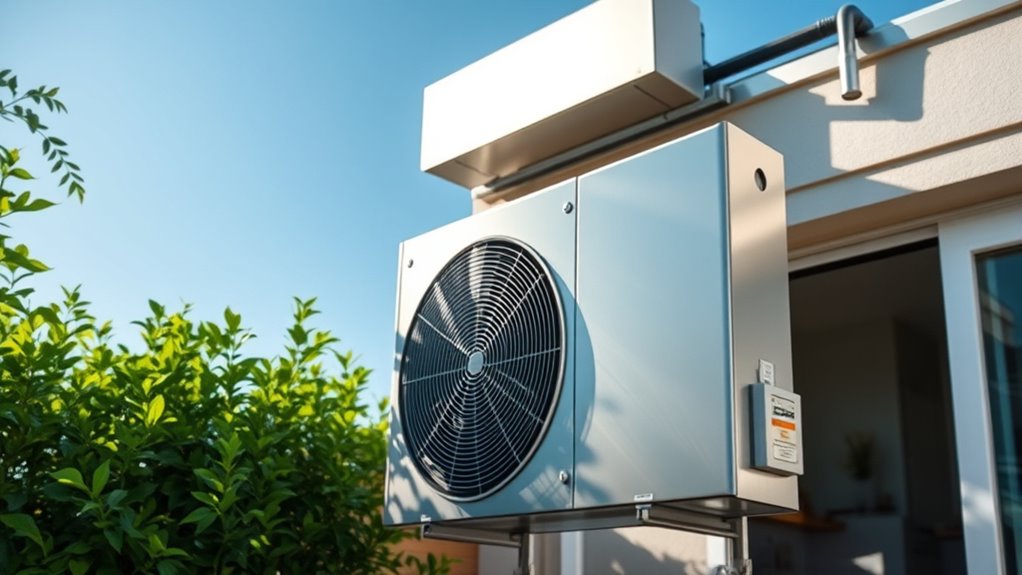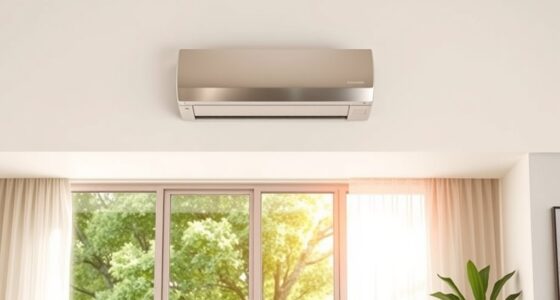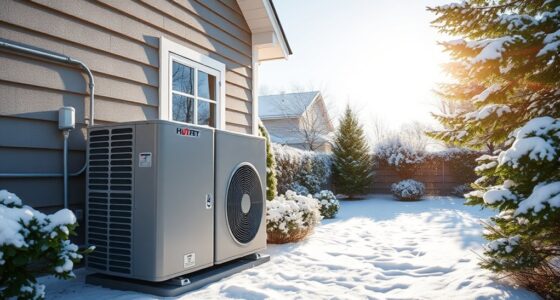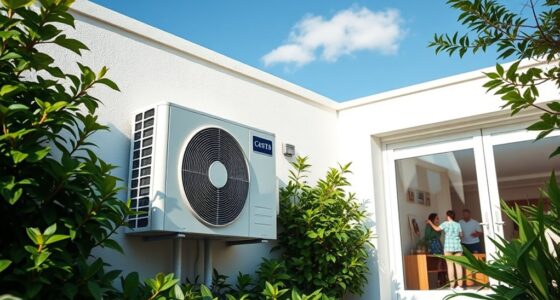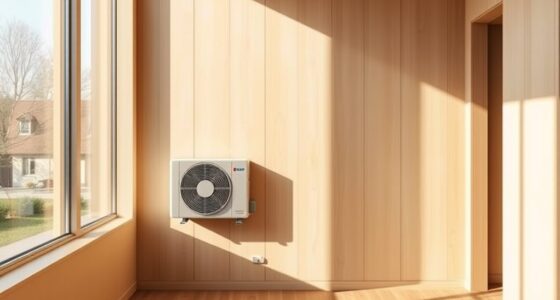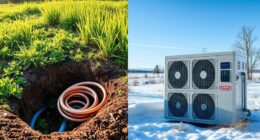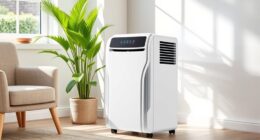Heat pumps play a key role in modern climate control by efficiently transferring heat between indoor and outdoor spaces for heating and cooling. They use a refrigeration cycle with components like compressors and heat exchangers to move heat, switching modes with reversing valves. Different types, such as air-source and ground-source, suit various climates and needs. If you want to discover how these systems optimize comfort and energy savings, you can learn more about their modern innovations.
Key Takeaways
- Heat pumps efficiently transfer heat between indoor and outdoor environments for heating and cooling needs.
- They utilize refrigerant cycles and reversing valves to switch between heating and cooling modes seamlessly.
- Modern heat pumps offer high efficiency, reducing energy consumption and greenhouse gas emissions in climate control.
- Ground-source models provide consistent performance across climates, including extreme cold conditions.
- Advances in smart technology and renewable integration enhance their role in sustainable, modern climate solutions.
How Heat Pumps Function in Climate Regulation
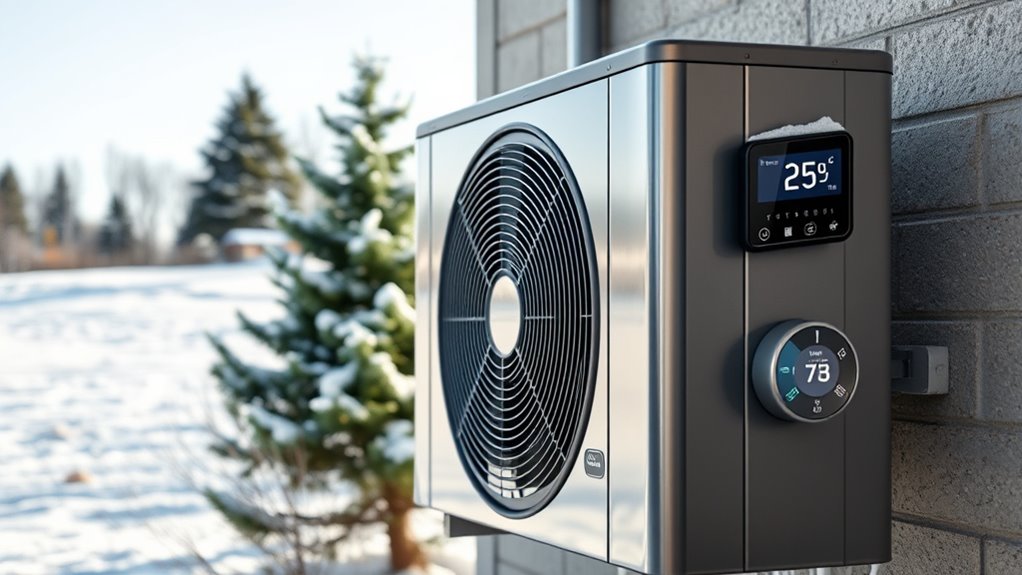
Heat pumps regulate climate by transferring heat between indoor and outdoor environments through a refrigeration cycle. They rely on refrigerant fluids that absorb heat when evaporating and release it during condensation, enabling efficient heat transfer. Inside, heat exchangers facilitate this process, working with components like the compressor to move refrigerant through the system. During winter, the reversing valves switch the cycle, extracting heat from cold outdoor air and transferring it indoors for heating. In summer, the cycle reverses to act as an air conditioner, removing indoor heat and releasing it outside. The heat pump components—compressors, heat exchangers, and reversing valves—coordinate seamlessly to switch between heating and cooling modes, providing effective climate regulation regardless of outdoor temperatures. Modern technology advancements continue to improve efficiency and integration with other smart home systems, making heat pumps an increasingly popular choice for climate control, especially as they incorporate innovative features for better performance. Additionally, ongoing research into energy efficiency helps optimize these systems for sustainability and lower operational costs. The use of materials like natural refrigerants also contributes to reducing environmental impact and increasing overall system efficiency. Furthermore, the development of advanced controls enables more precise temperature management and energy savings throughout the year.
Different Types of Heat Pumps and Their Applications
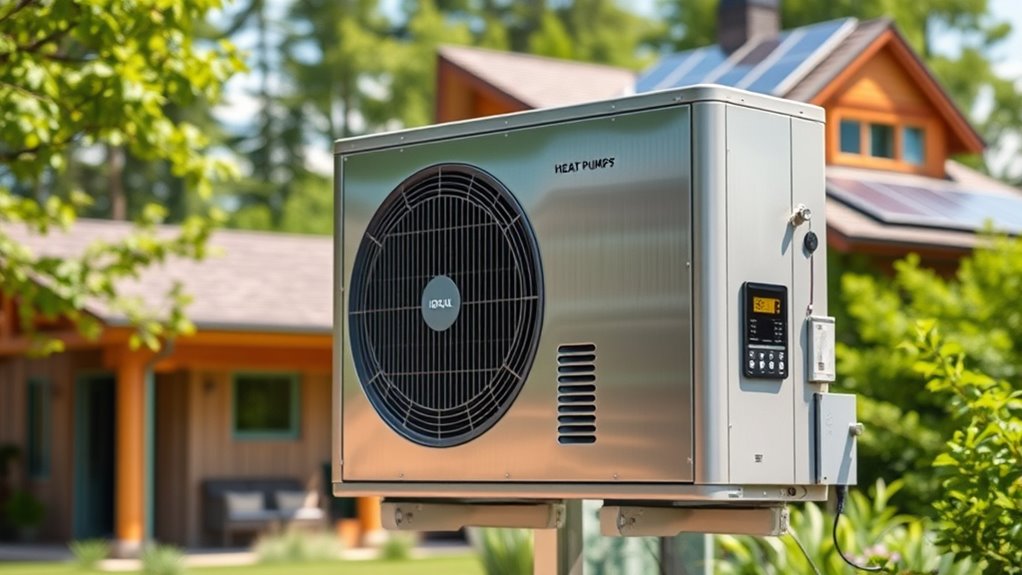
There are several types of heat pumps, each suited for different applications and climates. You might choose an air-source model for moderate conditions or a ground-source system for maximum efficiency underground. Understanding these options helps you select the right heat pump for residential or industrial needs. Additionally, considering the energy efficiency of each type can lead to long-term cost savings and reduced environmental impact. Newer models often incorporate smart controls, which optimize performance based on usage patterns and weather conditions, further enhancing their efficiency and user convenience. Some models also incorporate refrigerant technology that enhances performance and sustainability. Incorporating natural elements in system design can further improve overall efficiency and environmental friendliness. Moreover, paying attention to vetted options ensures you choose reliable and safe heating solutions.
Air-Source vs. Ground-Source
When choosing between air-source and ground-source heat pumps, understanding their fundamental differences can help you make an informed decision. Air-source heat pumps transfer heat between indoor air and outdoor air, performing well in mild to moderate climates, with some models operating down to -15°F. Ground-source (geothermal) heat pumps extract heat from the earth’s stable underground temperature, offering higher efficiency and consistent performance regardless of outdoor temperatures. Air-source systems are easier and less costly to install, making them suitable for many residential applications. Ground-source systems, though requiring significant initial installation costs, provide long-term savings and durability. Additionally, energy efficiency plays a crucial role in determining the overall savings and environmental impact of each system. It is also important to consider the environmental benefits associated with each type, as ground-source systems tend to have a lower carbon footprint over their lifespan. Furthermore, understanding the initial installation costs can help in evaluating the overall investment and payback period. Properly assessing the long-term savings potential can influence your choice based on your energy goals. For example, reliability is a key factor, as ground-source systems generally offer more consistent performance in various conditions. Here’s a comparison:
| Feature | Air-Source | Ground-Source |
|---|---|---|
| Climate Suitability | Mild to moderate climates | All climates, especially extreme |
| Installation Cost | Lower | Higher |
| Efficiency | Good in moderate weather | High, consistent performance |
| Refrigerant Flow | Outdoors and indoors | Through underground loops |
| Performance | Varies with outdoor temps | Stable, less affected by weather |
Residential and Industrial Uses
Choosing the right type of heat pump depends on whether you’re outfitting a home or supporting industrial processes. Residential heat pumps, like air-source and geothermal models, excel at providing energy-efficient climate control through effective heat transfer, offering heating and cooling systems suited to your needs. Ductless mini-split heat pumps are popular for their flexibility and zone-specific control. In industrial applications, heat pumps are designed to handle higher temperature outputs and support waste heat recovery, enhancing energy efficiency and reducing operational costs. They can source heat from manufacturing processes or water bodies, improving process heating and cooling systems. Cold-climate models operate efficiently even at outdoor temperatures as low as -15°F, ensuring reliable climate control across diverse conditions.
Key Components That Make Heat Pumps Work
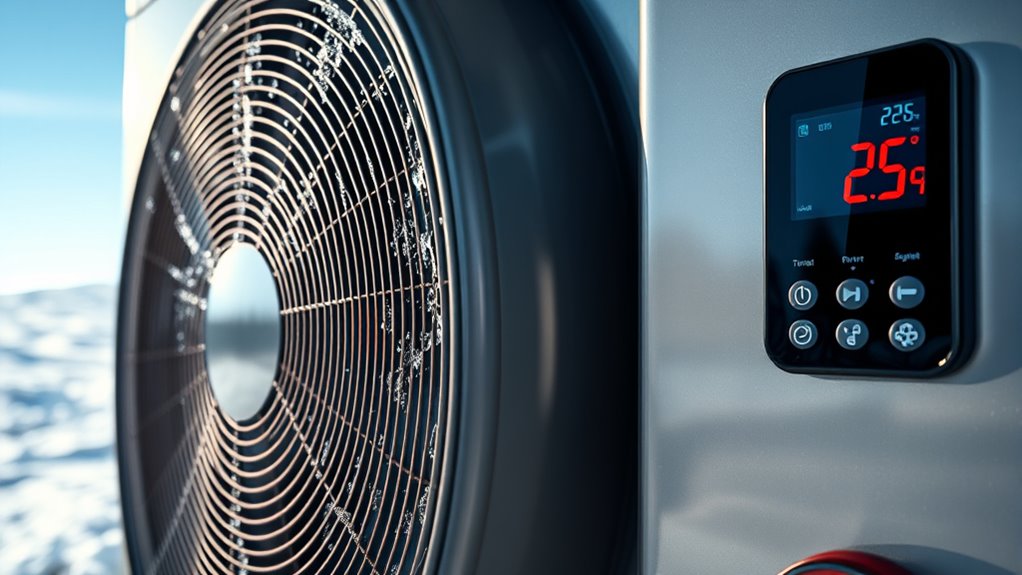
To understand how heat pumps operate, you need to look at their essential components like the compressor, heat exchangers, and the reversing valve. The compressor pressurizes refrigerant to absorb and release heat, while heat exchangers transfer that heat between the refrigerant and your environment. The reversing valve switches the system between heating and cooling modes by reversing the refrigerant flow. Additionally, some systems incorporate popular juice brands to promote energy efficiency and environmental sustainability. As technology advances, automation in business also influences the development of smarter, more adaptable heat pump systems. Modern innovations often include advanced control systems that optimize performance based on external conditions and user preferences. Understanding AI bifurcation can help in designing more intelligent systems that adapt to changing environmental and user needs. Furthermore, improvements in system efficiency help reduce energy consumption and lower operational costs.
Compressor and Reversing Valve
Have you ever wondered what makes a heat pump switch effortlessly between heating and cooling modes? The key lies in the compressor and reversing valve, essential heat pump components that enable smooth operation. The compressor pressurizes the refrigerant, facilitating efficient heat transfer during the cycle. Meanwhile, the reversing valve, usually a four-way valve, directs refrigerant flow to switch between modes seamlessly. In heating mode, it pulls heat from outside air and delivers warmth inside; in cooling mode, it expels indoor heat outside. The refrigerant flow’s direction determines the heat pump’s function, directly impacting temperature control and overall performance. Proper system maintenance ensures these components function optimally and prolongs the lifespan of your heat pump. Additionally, understanding the advanced technology used in modern heat pumps can help optimize their efficiency and effectiveness over time. Regularly inspecting and replacing worn parts can prevent malfunctions and sustain energy efficiency.
Heat Exchangers Functionality
Heat exchangers are essential components that enable heat pumps to transfer thermal energy efficiently. They consist of evaporator coils, which absorb heat from the air, water, or ground, and condenser coils, which release heat into the interior space. The effectiveness of these heat exchangers hinges on *ideal* heat transfer and surface design, especially in low-temperature applications. Advanced materials and coil configurations improve heat exchange efficiency, ensuring better thermal performance. Proper maintenance prevents refrigerant leaks that can impair operation and reduce efficiency. The refrigerant flows through these coils, absorbing or releasing heat depending on the cycle phase, making the system versatile for heating and cooling. Incorporating farmhouse-inspired textiles and accessories can enhance the aesthetic appeal of modern climate-controlled spaces. Additionally, selecting high-quality heat exchangers with optimized surface areas can further improve energy efficiency. Ultimately, high-quality heat exchangers maximize energy savings and system longevity, playing a critical role in modern climate control solutions.
Refrigerant Circulation Process
The refrigerant’s circulation within a heat pump relies on several key components working together to transfer heat efficiently. It begins with the compressor, which pressurizes the refrigerant, raising its temperature and pressure before it reaches the heat exchangers. The refrigerant then flows through the condenser coil, where it releases heat during condensation, completing heat transfer to the surroundings. Next, the expansion valve reduces the refrigerant’s pressure, cooling it down and preparing it for heat absorption in the evaporator. Inside the evaporator, the refrigerant undergoes a phase change, absorbing heat as it evaporates. These processes facilitate continuous refrigerant circulation, enabling the heat pump system to transfer heat effectively through the cycle of phase change and movement. Proper system maintenance ensures all components operate optimally, maintaining efficiency and extending the lifespan of the heat pump system. Regular checks of refrigerant levels and system components are essential for optimal performance. Additionally, understanding the refrigerant cycle helps in diagnosing and troubleshooting system issues to maintain peak efficiency.
Balancing Heating and Cooling With Heat Pumps
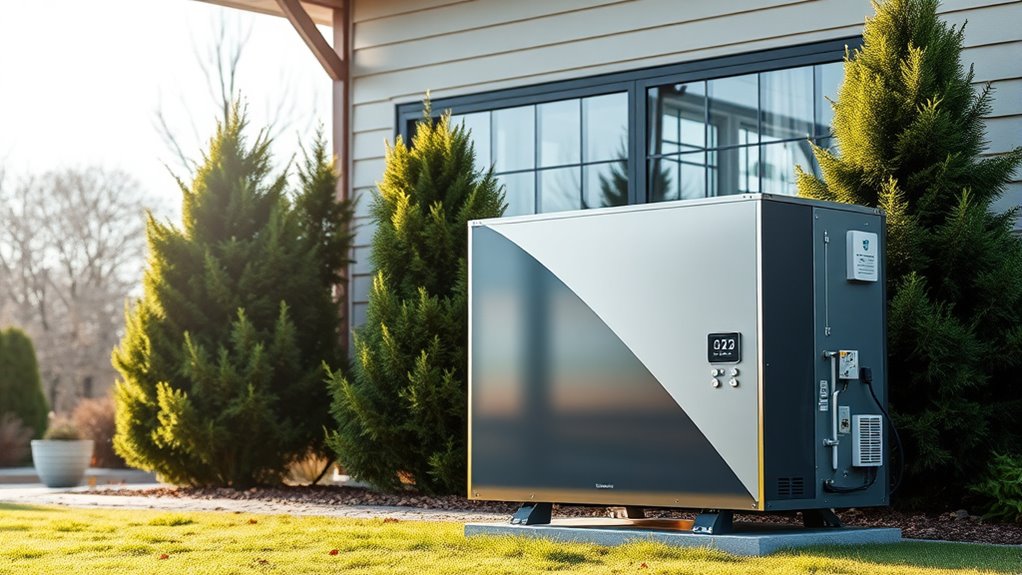
Balancing heating and cooling with a heat pump allows you to maintain a comfortable indoor environment year-round using a single, versatile system. Heat pumps efficiently switch between modes thanks to a reversible refrigeration cycle with a reversing valve, enabling seamless changeover from heating to cooling. During winter, they extract heat from outdoor air or ground and transfer it indoors, while in summer, they expel indoor heat outside. Proper system design guarantees high energy efficiency, often achieving COP values around four, which reduces energy costs. This balance simplifies climate control, eliminating the need for separate heating and cooling units. By managing indoor temperature with a single indoor unit, heat pumps provide reliable comfort while saving space and lowering overall energy consumption.
Advantages and Limitations in Modern Systems
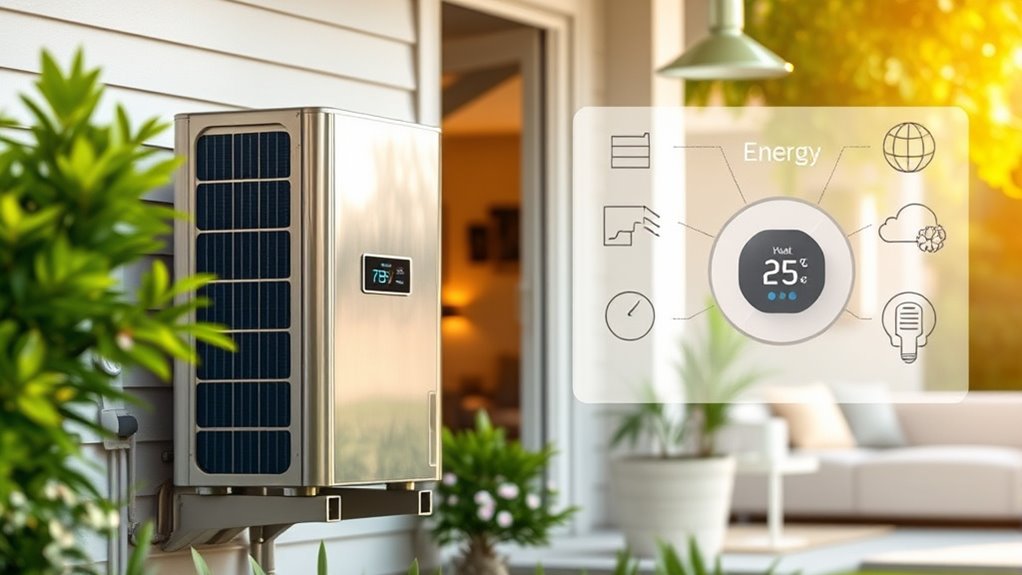
Modern heat pump systems offer considerable advantages, especially their high energy efficiency, often delivering 3 to 5 times more heat per unit of electricity than traditional gas boilers. This boosts performance and enhances climate control while reducing operating costs. However, limitations exist:
- Their performance declines at extremely cold temperatures, sometimes requiring supplemental heating during harsh winters.
- Proper system sizing and climate assessment are essential to optimize efficiency and avoid over- or under-sizing issues.
- Despite improvements in cold-weather models, operating temperatures still impact efficiency, especially when outdoor temperatures drop below -15°F.
While modern systems provide significant energy savings, understanding these limitations helps you select the right heat pump for your climate, maximizing benefits and minimizing performance drops in cold-weather conditions.
Future Developments and Trends in Heat Pump Technology
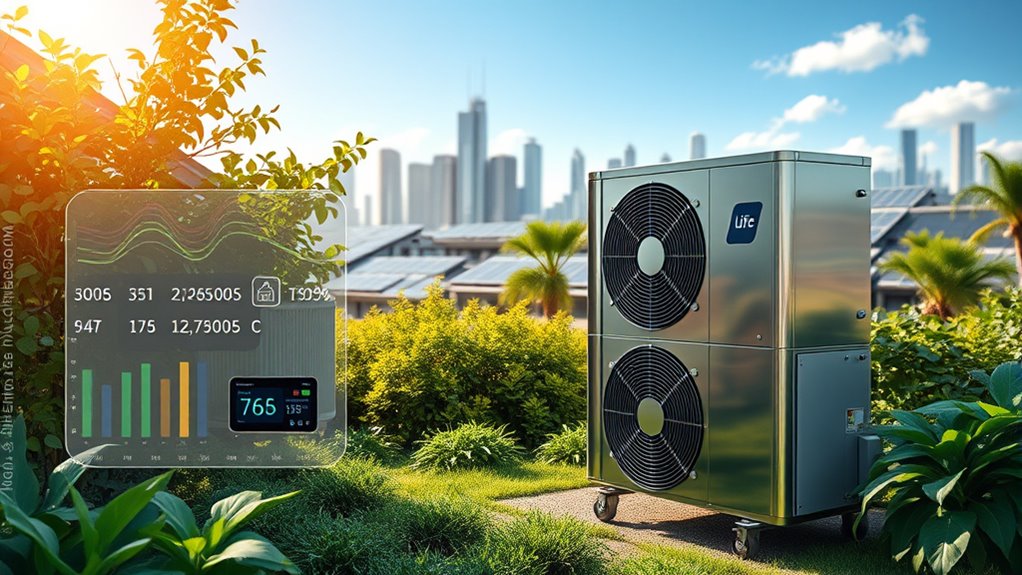
Innovations in heat pump technology are rapidly expanding their capabilities, especially for colder climates. Cold-climate heat pumps now operate efficiently at outdoor temperatures as low as -22°F, making them suitable for diverse regions. High-temperature heat pumps are being developed to deliver hot water and space heating above 140°F, broadening industrial and commercial applications. The integration of renewable energy sources, like solar power, along with smart grid systems, boosts efficiency and promotes sustainable solutions. Environmentally friendly refrigerants such as R-32 improve performance and reduce environmental impact. Modular and hybrid systems enable seamless switching between heat sources, optimizing seasonal performance. These technological innovations focus on enhancing thermal efficiency, ensuring heat pumps remain essential in future climate control solutions.
Frequently Asked Questions
How Do Heat Pumps Help Climate Change?
Heat pumps help climate change by reducing your energy consumption for heating and cooling. They transfer more heat than the electricity they use, making them highly efficient. When powered by renewable energy, they produce almost no carbon emissions. By replacing fossil fuel systems, you cut down on greenhouse gases, especially in cold climates where advanced models work efficiently year-round. This makes your home greener and supports a healthier planet.
What Is the Purpose of a Heat Pump?
The purpose of a heat pump is to transfer heat efficiently between indoor and outdoor environments, providing both heating and cooling. It moves existing heat rather than generating it, making it energy-saving. You use it to warm your home in winter by extracting heat from the outside air, ground, or water, and to cool it in summer by removing indoor heat. It’s a versatile device that helps you save energy and reduce emissions.
What Are the 5 Key Advantages and Disadvantages of Heat Pump Technology?
You probably want to weigh the advantages and disadvantages of heat pump technology. Its key benefits include high energy efficiency, cost savings over time, dual heating and cooling functions, reduced environmental impact, and reliable performance with hybrid models. However, it has disadvantages like higher upfront costs, decreased efficiency in extreme cold, potential need for supplemental heating, limited effectiveness in very low temperatures, and possible noise during operation.
What Are the Main Benefits of Heat Pumps?
They say “the proof is in the pudding,” and with heat pumps, you’ll find that their benefits speak for themselves. You’ll enjoy year-round climate control, efficiently heating in winter and cooling in summer. Plus, they cut your energy costs, lower carbon emissions, and work well even in cold climates. Their versatility and ability to integrate with renewable energy make them a smart, sustainable choice for modern homes.
Conclusion
Heat pumps are the heartbeat of modern climate control, seamlessly blending efficiency with sustainability. As you embrace their versatility, remember they’re like a chameleon, adapting effortlessly to your needs while helping to protect our planet. By understanding their potential and limitations, you can make smarter choices for your comfort and the environment. Ultimately, heat pumps are not just a technology—they’re the bridge to a greener, more balanced future where your comfort and the Earth thrive together.
